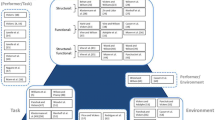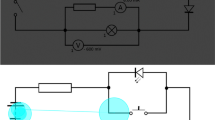Abstract
Contemporary theorizing on the complementary nature of perception and action in expert performance has led to different emphases in the study of movement coordination and gaze behavior. On the one hand, coordination research has examined the role of variability in movement control, evidencing that variability facilitates individualized adaptations during both learning and performance. On the other hand, and at odds with this principle, the majority of gaze behavior studies have tended to average data over participants and trials, proposing the importance of universal ‘optimal’ gaze patterns in a given task, for all performers, irrespective of stage of learning. In this article, we discuss new lines of inquiry with the aim of reconciling these two distinct approaches. We consider the role of inter- and intra-individual variability in gaze behaviors and suggest directions for future research.
Similar content being viewed by others
References
Aglioti SM, Cesari P, Romani M, et al. Action anticipation and motor resonance in elite baskbetball players. Nat Neurosci. 2008;11(9):1109–16.
Chemero A. Radical embodied cognitive science. Cambridge: MIT Press; 2009.
Davids K, Bennett S, Newell KM, editors. Movement system variability. Champaign: Human Kinetics; 2006.
Dicks M, Button C, Davids K. Examination of gaze behaviors under in situ and video simulation task constraints reveals differences in information pickup for perception and action. Atten Percept Psychophys. 2010;72(3):706–20. doi:10.3758/APP.72.3.706.
Causer J, Bennett S, Holmes PS, et al. Quiet eye duration and gun motion in elite shotgun shooting. Med Sci Sports Exerc. 2010;42(8):1599–608.
Savelsbergh GJP, van Gastel PJ, van Kampen PM. Anticipation of penalty kicking direction can be improved by directing attention through perceptual learning. Int J Sport Psychol. 2010;41(1):24–41.
Handford C, Davids K, Bennett S, et al. Skill acquisition in sport: some application of an evolving practice ecology. J Sports Sci. 1997;15:621–40.
Michaels CF, Carello C. Direct perception. Englewood Cliffs: Prentice Hall; 1981.
Savelsbergh GJP, Williams AM, van der Kamp J, et al. Visual search, anticipation and expertise in soccer goalkeepers. J Sports Sci. 2002;20(3):279–87.
Dicks M, Davids K, Button C. Representative task designs for the study of perception and action in sport. Int J Sport Psychol. 2009;40(4):506–24.
Huys R, Smeeton NJ, Hodges NJ, et al. On the dynamic information underlying visual anticipation skill. Percept Psychophys. 2008;70(1):1217–34.
Lopes JE, Jacobs DM, Travieso D, et al. Predicting the lateral direction of deceptive and non-deceptive penalty kicks in football from the kinematics of the kicker. Hum Mov Sci. 2014;36:199–216. doi:10.1016/j.humov.2014.04.004.
Vickers JN. Visual control when aiming at a far target. J Exp Psychol Hum Percept Perform. 1996;22(2):342–54.
Vickers JN. Perception, cognition, and decision training: the quiet eye in action. Champaign: Human Kinetics; 2007.
Gonzalez CC, Causer J, Miall RC, et al. Identifying the causal mechanisms of the quiet eye. Eur J Sport Sci. 2015. doi:10.1080/17461391.2015.1075595.
Rienhoff R, Tirp J, Strauss B, et al. The ‘quiet eye’ and motor performance: a systematic review based on Newell’s constraints-led model. Sports Med. 2016;46:589–603. doi:10.1007/s40279-015-0442-4.
Klostermann A, Kredel R, Hossner EJ. The quiet eye without a target: the primacy of visual information processing. J Exp Psychol Hum Percept Perform. 2013;40(6):2167–78. doi:10.1037/a0038222.
Vine SJ, Lee D, Moore LJ, et al. Quiet eye and choking: online control breaks down at the point of performance failure. Med Sci Sports Exerc. 2013;45(10):1988–94. doi:10.1249/MSS.0b013e31829406c7.
Najemnik J, Geisler WS. Optimal eye movement strategies in visual search. Nature. 2005;434:387–91. doi:10.1038/nature03390.
Vine SJ, Moore LJ, Wilson MR. Quiet eye training facilitates competitive putting performance in elite golfers. Front Psychol. 2011;2(8):1–9. doi:10.3389/fpsyg.2011.00008.
Klostermann A, Vater C, Kredel R, et al. Perceptual training in beach volleyball defence: different effects of gaze-path cueing on gaze and decision-making. Front Psychol. 2015;6:1–13. doi:10.3389/fpsyg.2015.01834.
Land MF. Eye movements and the control of actions in everyday life. Prof Retin Eye Res. 2006;25:296–324.
Hayhoe M. Vision using routines: a functional account of vision. Vis Cogn. 2000;7:43–64.
Fehd HM, Seiffert AE. Eye movements during multiple object tracking: where do participants look? Cognition. 2008;108:201–9. doi:10.1016/j.cognition.2007.11.008.
Zelinsky GJ, Neider MB. An eye movement analysis of multiple object tracking in a realistic environment. Vis Cogn. 2008;16(5):553–66. doi:10.1080/13506280802000752.
Kanai R, Rees G. The structural basis of inter-individual differences in human behaviour and cognition. Nat Rev Neurosci. 2011;12:231–42.
Speelman CP, McGann M. How mean is the mean? Front Psychol. 2013;4:1–12. doi:10.3389/fpsyg.2013.00451.
Mann DTY, Williams AM, Ward P, et al. Perceptual cognitive expertise in sport: a meta-analysis. J Sport Exerc Psychol. 2007;29:457–78.
Thelen E. Development as a dynamic system. Curr Dir Psychol Sci. 1992;1(6):189–93.
Newell KM, Liu YT, Mayer-Kress G. Time scales in motor learning and development. Psychol Rev. 2001;108(1):57–82. doi:10.1037//0033-295X.108.1.57.
Seifert L, Button C, Davids K. Key properties of expert movement systems in sport: an ecological dynamics perspective. Sports Med. 2013. doi:10.1007/s40279-012-0011-z.
Latash ML. The bliss (not the problem) of motor abundance (not redundancy). Exp Brain Res. 2012;217:1–5. doi:10.1007/s00221-012-3000-4.
Müller H, Sternad D. Decomposition of variability in the execution of goal-oriented tasks: three components of skill improvement. J Exp Psychol Hum Percept Perform. 2004;30(1):212–33. doi:10.1037/0096-1523.30.1.212.
Newell KM, Mayer-Kress G, Liu YT. Human learning: power laws or multiple characteristic time scales? Tutor Quant Methods Psychol. 2006;2(2):66–76.
Loeb GE. Optimal isn’t good enough. Biol Cybern. 2012;106:757–65. doi:10.1007/s00422-012-0514-6.
Rein R, Davids K, Button C. Adaptive and phase transition behavior in performance of discrete multi-articular actions by degenerate neurobiological systems. Exp Brain Res. 2010;201:307–22. doi:10.1007/s00221-009-2040-x.
Hamill J, van Emmerik REA, Heidersheit BV, Li L. A dynamical systems approach to lower extremity running injuries. Clin Biomech. 1999;14(5):297–308. doi:10.1016/S0268-0033(98)90092-4.
Bernstein NA. The control and regulation of movements. London: Pergamon Press; 1967.
Chow JY, Davids K, Button C, et al. Coordination changes in a discrete multi-articular action as a function of practice. Acta Psychol. 2008;127:163–76.
Bril B, Rein R, Nonaka T, et al. The role of expertise in tool use: skill differences in functional action adaptations to task constraints. J Exp Psychol Hum Percept Perform. 2010;36(4):825–39. doi:10.1037/a0018171.
Newell KM, Liu YT, Mayer-Kress G. Learning in the brain-computer interface: insights about degrees of freedom and degeneracy from a landscape model of motor learning. Cogn Process. 2005;6:37–47.
Brison TA, Claude A. Should common optimal movement patterns be identified as the criterion to be achieved. J Mot Behav. 1996;28(3):211–23.
Frank TD, Michelbrink M, Beckmann H, et al. A quantitative dynamical systems approach to differential learning: self-organization principals and order parameter equations. Biol Cybern. 2008;98:19–31.
Hong SL, Newell KM. Practice effects on local and global dynamics of the ski-simulator task. Exp Brain Res. 2006;169:350–60.
Edelman GM, Gally JA. Degeneracy and complexity in biological systems. Proc Natl Acad Sci USA. 2001;98(24):13763–8.
Anderson ML. Neural reuse: a fundamental organizational principles of the brain. Behav Brain Sci. 2010;33:245–313. doi:10.1017/S0140525X10000853.
Royal KA, Farrow D, Mujika I, et al. The effects of fatigue on decision making and shooting skill performance in water polo players. J Sports Sci. 2006;24(8):807–15.
Price CJ, Friston KJ. Degeneracy and cognitive anatomy. Trends Cogn Sci. 2002;6(10):416–21.
Croft J, Button C, Dicks M. Visual strategies of sub-elite cricket batsmen in response to different ball velocities. Hum Mov Sci. 2010;29(5):751–63.
Mann DL, Spratford W, Abernethy B. The head tracks and gaze predicts: how the world’s best batters hit a ball. PLoS One. 2013;8(3):e58289. doi:10.1371/journal.pone.0058289.
Mann DTY, Coombes SA, Mousseau MB, et al. Quiet eye and the Bereitschaftspotential: visuomotor mechanisms of expert motor performance. Cogn Process. 2011;12:223–34.
Chia JS, Chow JY, Kawabata M, et al. An exploratory analysis of quiet eye duration within and between levels of expertise. Int J Sport Exerc Psychol. 2016. doi:10.1080/1612197X.2015.1114503.
Savelsbergh GJP, van der Kamp J, Oudejans RR, et al. Perceptual learning is mastering perceptual degrees of freedom. In: Williams AM, Hodges NJ, editors. Skill acquisition in sport: research, theory and practice. London: Routledge, Taylor & Francis; 2004. p. 374–389.
de Oliveira RF, Oudejans RRD, Beek PJ. Gaze behavior in basketball shooting: further evidence for online visual control. Res Q Exerc Sport. 2008;79(3):399–404.
Oudejans RRD, van de Langenberg RW, Hutter RI. Aiming at a far target under different viewing conditions: visual control in basketball jump shooting. Hum Mov Sci. 2002;21:457–80.
de Oliveira RF, Oudejans RRD, Beek PJ. Late information pick up is preferred in basketball jump shooting. J Sports Sci. 2006;24:933–40.
Button C, MacLeod M, Sanders R, et al. Examining movement variability in the basketball free-throw action at different skill levels. Res Q Exerc Sport. 2003;74(3):257–69.
Mullineaux DR, Uhl TL. Coordination-variability and kinematics of misses versus swishes of basketball free throws. J Sports Sci. 2010;28(9):1017–24. doi:10.1080/02640414.2010.487872.
Bootsma RJ, van Wieringen PCW. Timing an attacking forehand drive in table tennis. J Exp Psychol Hum Percept Perform. 1990;16(1):21–9.
Dicks M, Button C, Davids K. Availability of advance visual information constrains association-football goalkeeping performance during penalty kicks. Perception. 2010;39:1111–24.
Navia JA, Dicks M, van der Kamp et al. Gaze control during interceptive actions with different spatiotemporal demands. J Exp Psychol Hum Percept Perform. 2016 (under review).
Button C, Dicks M, Haines R, et al. Statistical modelling of gaze behaviour as categorical time series: what you should watch to save soccer penalties. Cogn Process. 2011;12:235–44. doi:10.1007/s10339-010-0384-6.
Huet M, Jacobs DM, Camachon C, et al. The education of attention as explanation of variability of practice effects: learning the final approach phase in a flight simulator. J Exp Psychol Hum Percept Perform. 2011;37(6):1841–54. doi:10.1037/a0024386.
Andrieux M, Proteau L. Observation learning of a motor task: who and when? Exp Brain Res. 2013;229(1):125–37. doi:10.1007/s00221-013-3598-x.
Dicks M, van der Kamp J, Withagen R, et al. Can we hasten expertise by video simulations? Considerations from an ecological psychology perspective. Int J Sport Psychol. 2015;45(6):109–29. doi:10.7352/IJSP2015.46.000.
Cumming G. The new statistics: why and how. Psychol Sci. 2014;25(1):7–29. doi:10.1177/0956797613504966.
Author information
Authors and Affiliations
Corresponding author
Ethics declarations
Funding
No sources of funding were used to assist in the preparation of this review.
Conflict of interest
Matt Dicks, Chris Button, Keith Davids, Jia Yi Chow, and John van der Kamp have no conflicts of interest relevant to the content of this review.
Rights and permissions
About this article
Cite this article
Dicks, M., Button, C., Davids, K. et al. Keeping an Eye on Noisy Movements: On Different Approaches to Perceptual-Motor Skill Research and Training. Sports Med 47, 575–581 (2017). https://doi.org/10.1007/s40279-016-0600-3
Published:
Issue Date:
DOI: https://doi.org/10.1007/s40279-016-0600-3




